
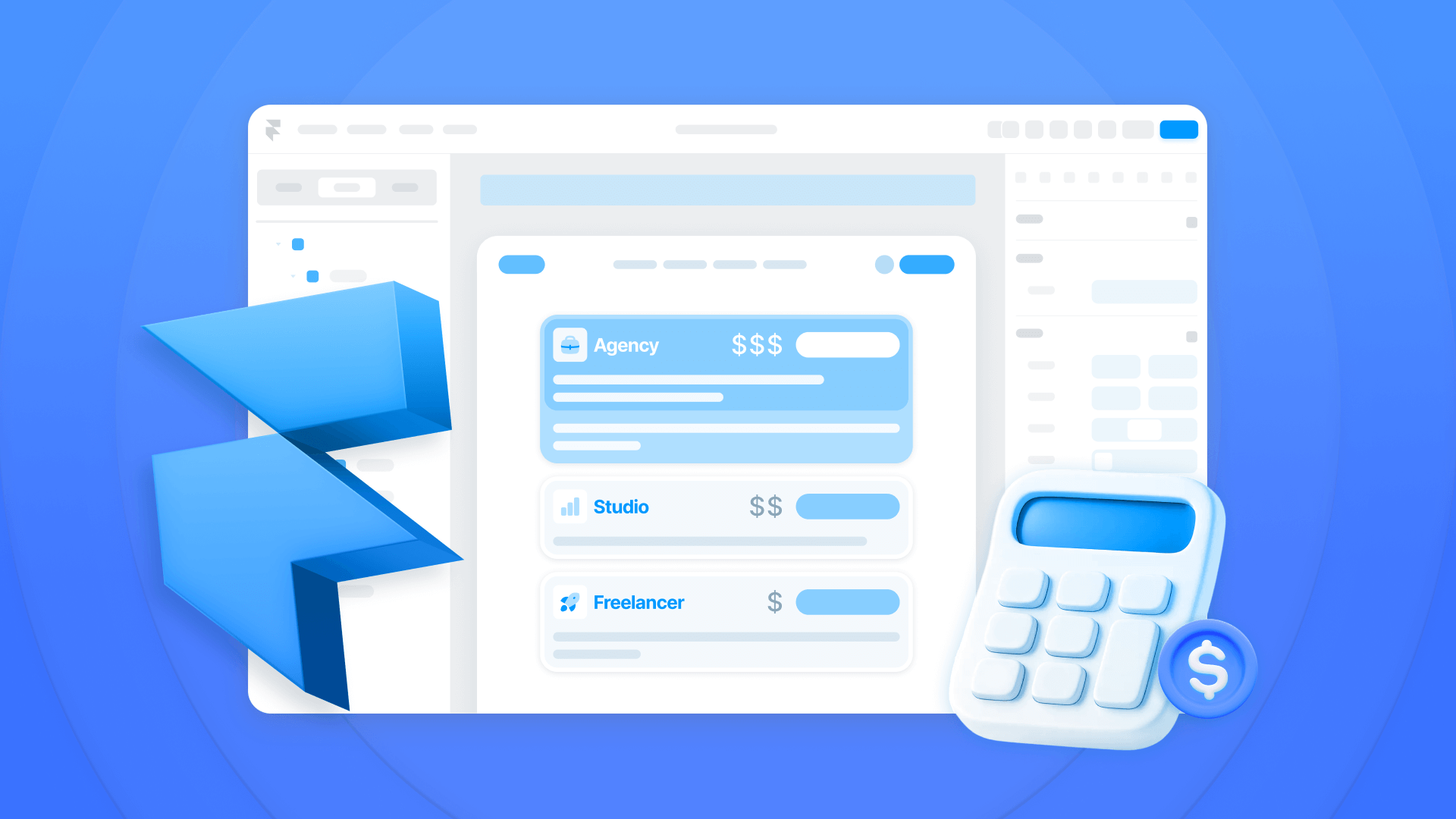
Framer website pricing can be confusing when you're trying to budget for a project. The same 10-page marketing website might receive a $8,000 quote from one vendor and $35,000 from another, with both appearing equally capable.
The issue isn't providers concealing their pricing – it's that scope complexity fluctuates dramatically and vendor expertise covers a massive spectrum. A solo freelancer's definition of "straightforward marketing site" differs entirely from an enterprise agency's interpretation of the same requirements with their established QA frameworks.
The truth is that Framer website pricing follows recognizable patterns once you grasp the two elements that influence every proposal: your project's complexity and the agency tier you select. This resource analyzes actual pricing information from numerous agencies, freelancers, and subscription programs to help you plan budgets realistically and assess proposals with clarity.
We'll explain the calculation method for project pricing, present genuine pricing from subscription programs and retainers, and provide a comparison framework for evaluating proposals effectively. You'll recognize when a $3,000 proposal is appropriate and when a $50,000 commitment represents the correct decision.
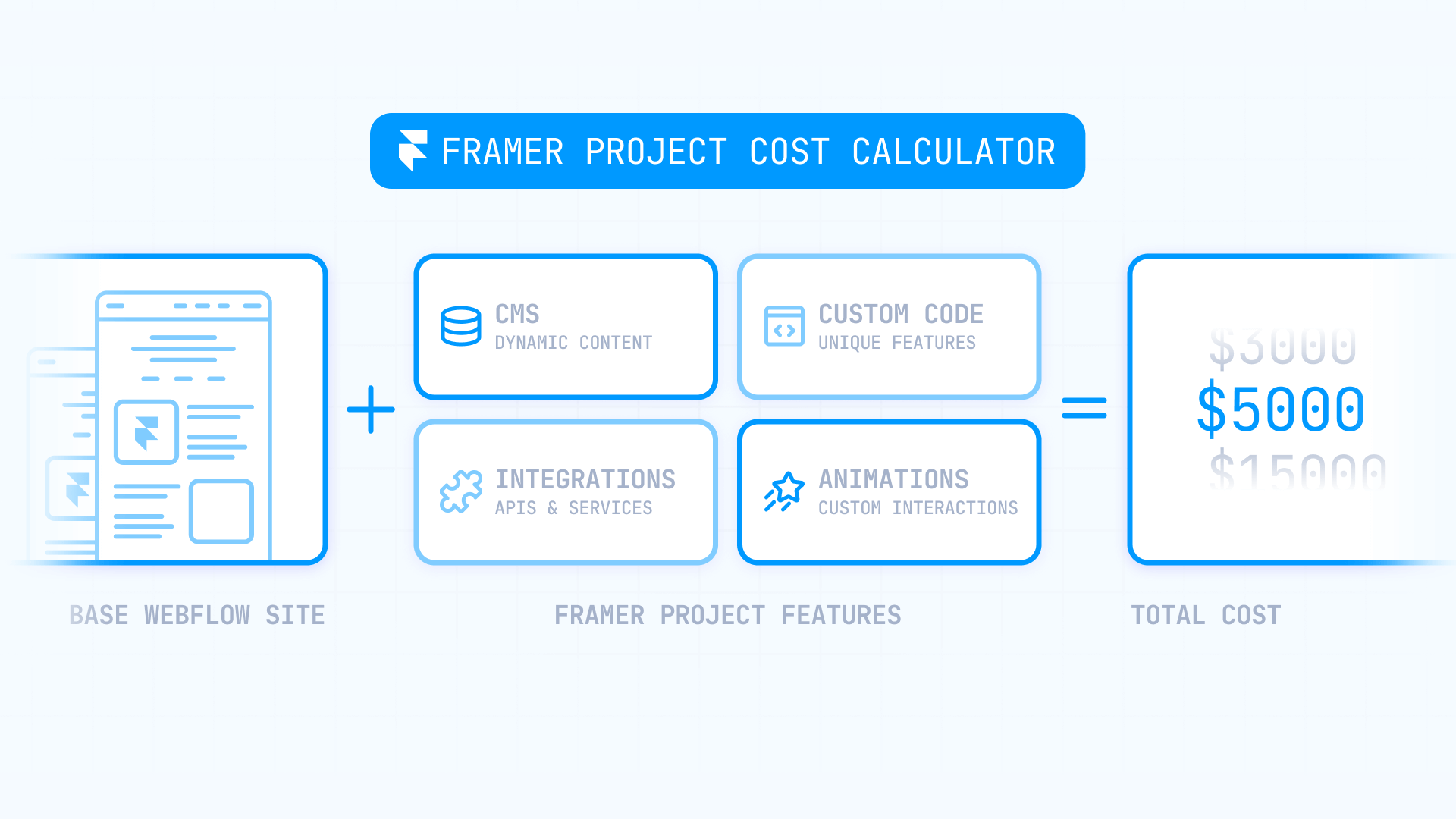
Why finding accurate costs and the right Framer provider proves challenging
The Framer marketplace presents several pricing structures among agencies and freelancers, each carrying unique compromises that complicate straightforward comparisons. Identifying which structure suits your needs matters beyond pursuing the cheapest advertised rate.
Here's what you'll discover when researching Framer services:
Hourly rates for Framer development: Payment based on actual hours worked, usually $50-$200/hour depending on hiring a freelancer versus an established agency. This approach offers flexibility but complicates budgeting since total expenses remain unknown initially. Suitable for minor tasks or undefined scope, but not advised for complete website projects where expenses can escalate rapidly
Fixed-price Framer builds: Agencies and freelancers provide total project costs for specified deliverables, ensuring budget certainty but demanding detailed scope documentation beforehand. Ideal for new launches or redesigns with defined specifications, but any scope modifications generate supplementary fees that accumulate quickly
Monthly Framer retainers: You purchase predetermined hours monthly (such as 20, 50, or 100 hours) at reduced rates compared to hourly charges. This arrangement suits continuous maintenance and modifications after site launch, allowing predictable cost distribution while establishing a productive relationship with your vendor
Unlimited Framer subscriptions: Flat monthly payment for "unlimited" tasks, but assignments proceed through a queue with generally one active task at a time. Favored for constant updates at stable costs, though "unlimited" actually means "as much as deliverable within our queue limitations and 48-72 hour turnarounds"
The growth in unlimited subscription offerings has complicated pricing evaluations further because they're providing capacity and response time instead of concrete deliverables or hours. A $2,500/month subscription can't be directly measured against a $20,000 fixed build or a 50-hour retainer without grasping throughput and queue mechanics.
Before evaluating costs, determine which structure genuinely matches your workflow: Do you have a single project with defined boundaries? Continuous updates with fluctuating volume? Regular iteration requirements? Your operational situation should determine the pricing structure, not simply what appears most economical initially.
The straightforward calculation for Framer website pricing
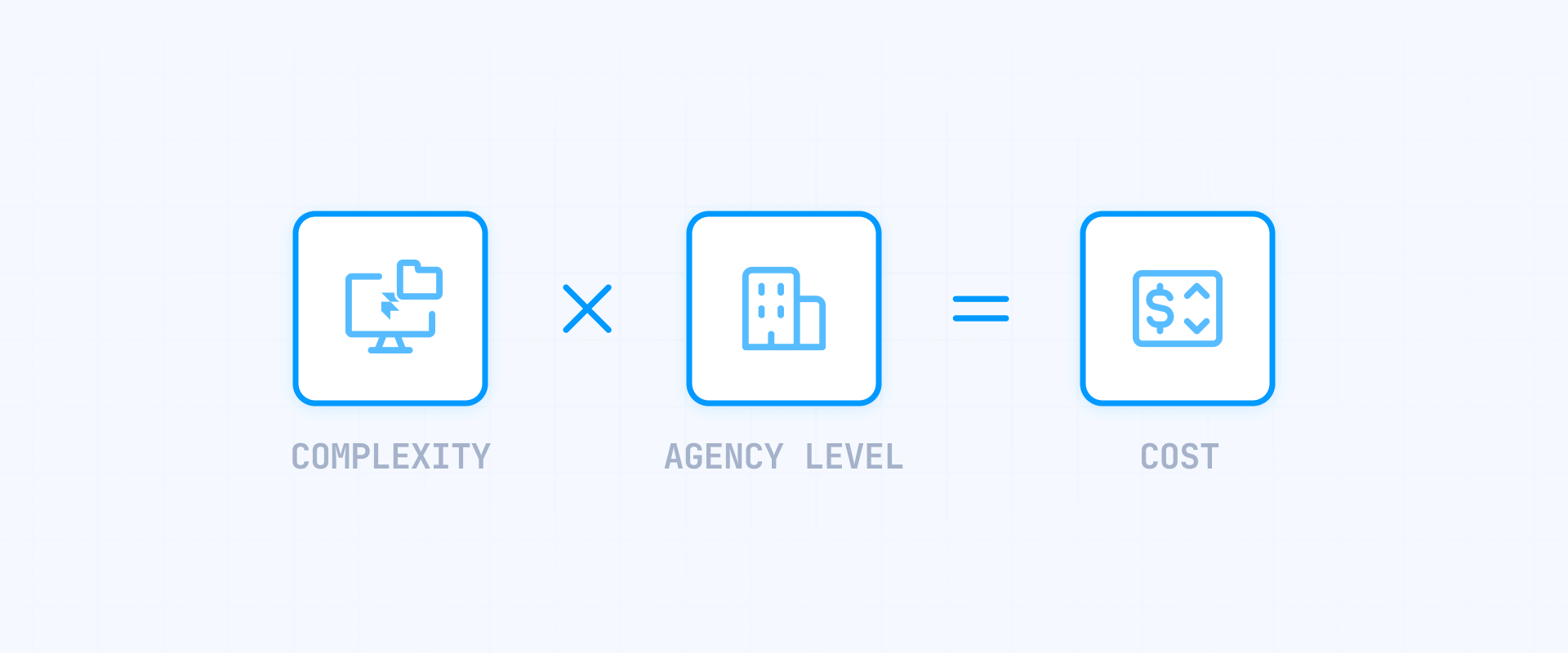
Framer project pricing reduces to a clear formula that accounts for 90% of the variation you'll encounter in proposals:
Estimated Cost = Project Complexity × Agency Level × $3,000
This calculation functions because complexity establishes the volume of work needed, while agency level establishes the rate and process overhead brought to that work. Additional elements like your geography, timeline urgency, or a vendor's standing can adjust prices moderately higher or lower, but they're not the primary influences.
Grasping these two multipliers enables you to verify whether the proposal you're receiving aligns with market standards for the quality tier you require, or if you're paying excessive amounts.
Defining Framer project complexity tiers
Project complexity establishes the foundational work scope before considering who's implementing it. Here's how to classify your project:
- Small projects: 1-10 pages featuring minimal interactions and no intricate integrations. Consider landing pages, basic portfolios, or fundamental company websites with contact forms. These builds generally require 1-3 weeks for skilled teams
- Medium projects: 11-40 pages incorporating CMS collections, moderate interactions, and basic third-party connections. Typical examples include marketing websites with blog systems, service business sites with case study collections, or agency portfolios with filtering capabilities
- Large projects: 41-100 pages featuring sophisticated CMS structure, numerous integrations, extensive custom interactions, and design frameworks. These encompass SaaS marketing websites with comprehensive documentation, multi-product business sites, or platform landing pages with advanced filtering
- Enterprise projects: 101-200+ pages requiring multi-locale capabilities, sophisticated CMS architecture, compliance requirements, custom API connections, extensive migrations maintaining SEO parity, structured QA procedures, and accessibility standards. Consider global business sites, regulated sector platforms, or comprehensive documentation frameworks
Understanding Framer agency tier levels and expertise
Agency tier levels represent process sophistication, team scale, and standard client profiles beyond simple hourly rates. Here's how to align your requirements with the appropriate tier:
- Top agencies: Award-winning teams featuring enterprise-level procedures, specialized QA, structured strategy stages, and demonstrated large-scale execution. Teams such as Aerolab, BRIX Agency, and Deserve Studio occupy this tier. These agencies establish project minimums – BRIX Agency begins at $10,000 while Aerolab starts at $20,000+ – representing varied operational frameworks but reliably high benchmarks
- Mid-level agencies: 5-15 person studios featuring established procedures and transparent services. They've executed sufficient projects to develop systems, frequently operate monthly capacity offerings or retainers, and collaborate with businesses requiring dependable execution without enterprise infrastructure
- Small or emerging studios: Recent agencies developing their procedures, frequently featuring restricted capacity and focused specialization. They provide more accessible pricing while expanding their portfolio and refining their frameworks
- Freelancers: Independent contractors featuring the minimal overhead and widest rate variation. Quality spans considerably, but seasoned freelancers frequently produce outstanding work at reasonable price levels
Market-validated pricing ranges for Framer builds
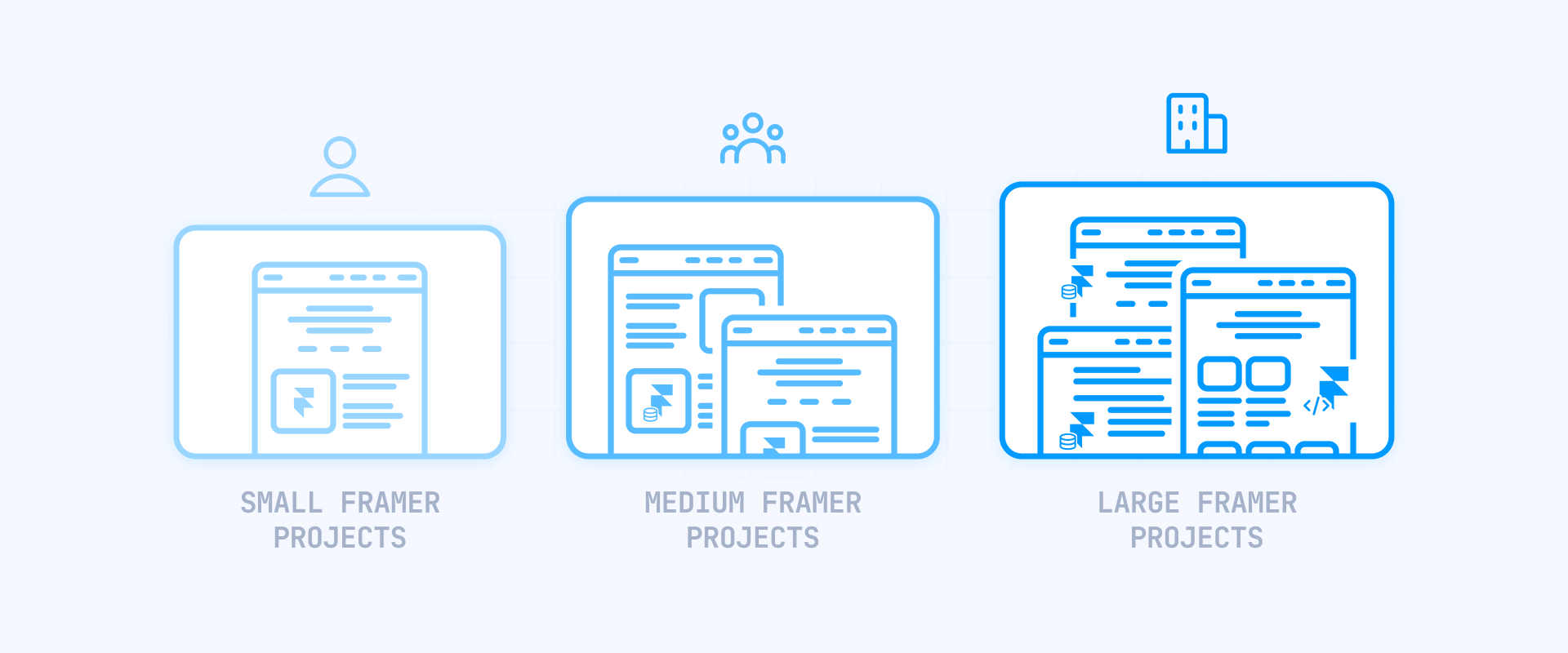
These ranges represent genuine market rates derived from transparent agency pricing, confirmed proposals from developer communities, and recorded retainer offerings. Apply them as sanity checks against proposals you obtain.
The analyses below display standard project expenses by merging complexity tier with agency quality tier:
Small Framer projects (1-10 pages)
- Freelancers: $1,800-$4,500 supported by consistent quotes in developer communities for fundamental builds
- Small studios: $3,600-$9,000 reflecting capacity-based pricing and studio overhead
- Mid-level agencies: $7,200-$18,000 including established processes and dedicated account management
- Top agencies: $12,600-$31,500 for projects meeting their minimum thresholds with full service capabilities
These ranges assume basic interactivity, straightforward content structure, and standard form integration. Landing pages frequently fall toward the lower boundaries, while small marketing sites requiring custom animations trend toward upper limits.
Medium Framer projects (11-40 pages, CMS)
- Freelancers: $4,500-$9,000 for experienced independent developers managing moderate complexity
- Small studios: $9,000-$18,000 providing team backup and foundational project management
- Mid-level agencies: $18,000-$36,000 featuring proven delivery systems and comprehensive QA coverage
- Top agencies: $31,500-$63,000 incorporating strategy phases, specialized development, and structured procedures
Medium projects typically incorporate CMS collections, custom filtering, moderate third-party integrations, and responsive design systems. The broad pricing variance represents differences in design sophistication, interaction complexity, and integration depth.
Large Framer projects (41-100 pages, heavy interactions/integrations)
- Freelancers: $9,000-$18,000 though uncommon at this scale
- Small studios: $18,000-$36,000 for studios with proven capacity management
- Mid-level agencies: $36,000-$72,000 featuring dedicated teams and structured delivery
- Top agencies: $63,000-$126,000 incorporating enterprise-grade procedures and comprehensive support
Large projects demand sophisticated CMS architecture, numerous custom integrations, comprehensive interaction libraries, and design systems requiring dedicated team coordination. These typically span 2-4 months for proper execution.
Enterprise Framer projects (101-200+ pages, multi-locale/API/migration/QA)
- Small studios: $18,000-$51,000 for simplified enterprise-level builds
- Mid-level agencies: $72,000-$102,000 featuring established enterprise procedures
- Top agencies: $126,000-$178,500+ incorporating comprehensive strategy, specialized development, structured QA, and dedicated account teams
Enterprise builds incorporate multi-language capabilities, sophisticated CMS frameworks, custom API integrations, extensive content migrations preserving SEO value, accessibility compliance, and structured QA procedures. Timeline typically spans 3-6+ months.
Real subscription and retainer pricing for Framer services
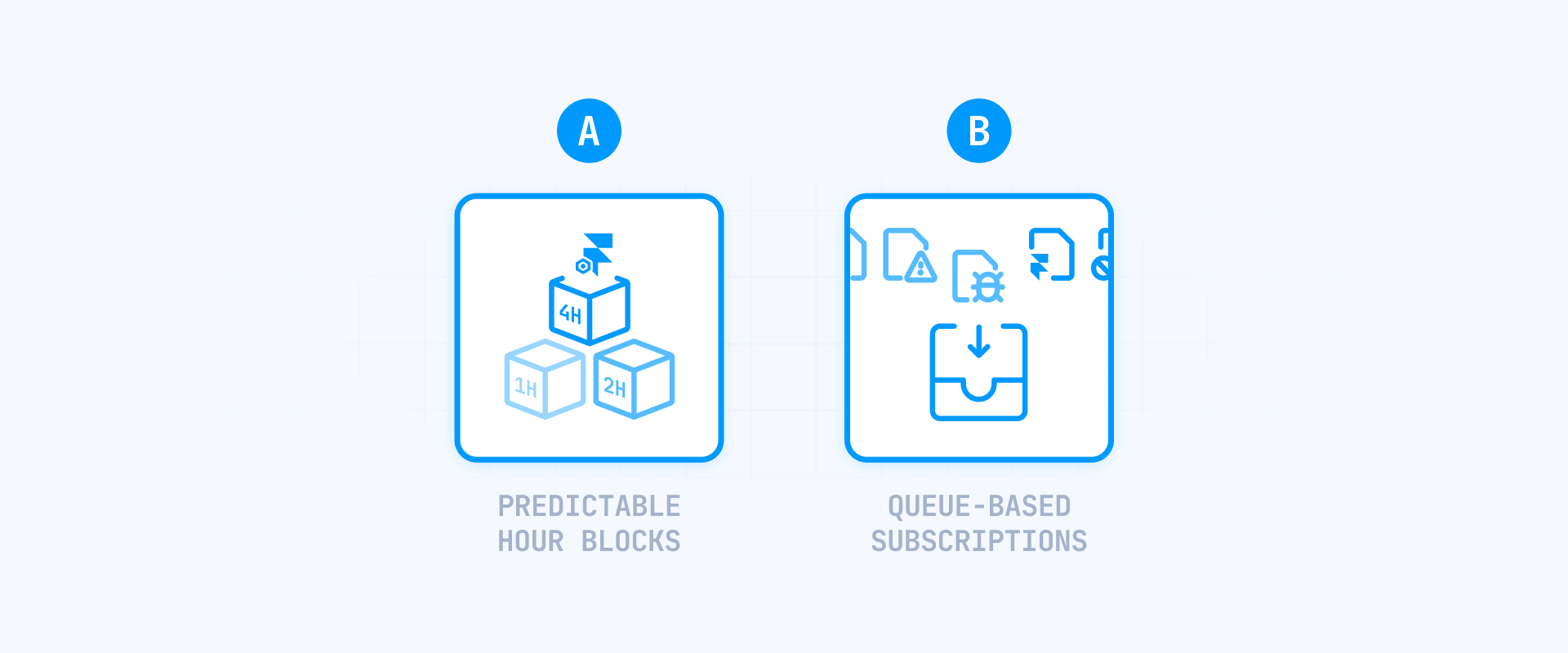
Subscription and retainer models provide alternatives to fixed projects, each featuring distinct advantages and constraints. Understanding actual market pricing enables realistic comparisons.
Unlimited Framer subscription services
Current market offerings for "unlimited" Framer subscriptions:
- Framerfry: $2,499/month with one active request, 24-48 hour turnaround cycles
- subscription.framer.media: $2,995/month with one request at a time, approximately 48-hour turnaround, plus $995 for Framer development addition
- Swifty: $2,990/month offering one or two requests at a time, approximately 48-hour delivery
- Pixlta: $4,995/month featuring one request at a time with 2-day completion
- forr.framer.website: $1,999/month with one request at a time, plus week trial for $499
These services function through task queues rather than parallel work streams. The "unlimited" designation indicates you can submit continuous requests, but execution proceeds sequentially. A complicated feature requiring multiple revision cycles will consume numerous 48-hour cycles, making these slower than dedicated teams for intricate work.
Subscriptions excel for steady small-to-medium updates, continuous optimization, and regular content modifications. They struggle with parallel feature development or projects demanding simultaneous work across multiple site areas.
Framer retainer packages
Retainer arrangements typically offer purchased hours monthly with defined service level agreements:
- Light retainers: $100-$500/month for minimal upkeep covering basic content updates and minor modifications
- Standard retainers: $2,000-$4,000/month providing 20-40 hours for continuous maintenance and moderate feature additions
- Heavy retainers: $4,000-$7,500/month offering 50-80 hours for substantial ongoing development and optimization
Quality retainers specify response time SLAs, rollover policies for unused hours, and explicit boundaries between included services and billable projects. Common exclusions: brand design work, major redesigns, complex custom code, and new integrations.
Essential cost factors affecting Framer project pricing

Multiple elements influence final project costs beyond base complexity. Understanding these helps you anticipate which proposals will trend toward higher ranges.
Technical complexity drivers for Framer builds
- Page and template quantity: Each unique template design increases design and development time considerably
- CMS architecture depth: Simple collections versus complex relational structures with conditional logic
- Animation and interaction complexity: Basic hover states versus sophisticated scroll-triggered animations and custom interactions
- Integration requirements: Number and sophistication of third-party service connections
- Multi-locale implementation: Translation management, regional content variations, and localized URL structures
- Migration scope: Content volume, URL mapping complexity, and SEO preservation requirements
- Timeline urgency: Accelerated schedules requiring dedicated resources or overtime
- QA coverage: Testing depth, browser coverage, device testing, and accessibility audits
Framer platform costs affecting total ownership
Framer platform costs extend beyond development fees and impact ongoing budgets:
- Plan tiers: Basic $10/month, Pro $30/month, Scale $100/month plus usage-based charges
- Editor seats: Basic $20/editor, Pro and Scale $40/editor; plans include 2-10 seats depending on tier
- Locales: $20/locale for multi-language implementations
- A/B testing: $50 per 500,000 events for conversion optimization testing
- Custom proxy: $300 for custom domain proxying
- Bandwidth overages: Scale plan provides 200GB, then $40 per 100GB
- Page overages: Plans include 30-300 pages, then $20 per 100 pages
- CMS collection overages: Plans include 1-20 collections, then $40 per 10 collections
- CMS item overages: Plans include 1,000-10,000 items, then $20 per 10,000 items
Factor these expenses into total cost of ownership calculations, particularly for sites requiring multiple editors, extensive localization, or substantial content volumes.
How to evaluate Framer agency proposals effectively

Comparing proposals requires examining beyond headline pricing. Use this framework to assess whether quotes genuinely represent comparable offerings.
Critical questions for Framer agencies
Ask these during discovery calls to understand what's truly included:
- What's your typical project process? Quality agencies articulate clear phases from discovery through launch
- What specific deliverables are included? Ensure proposals specify design files, development, QA coverage, training, and post-launch support
- How do you handle scope changes? Understand change order processes and additional pricing
- What's your revision policy? Confirm how many design and development revision rounds are included
- Who's actually building the site? Junior developers cost less but deliver inconsistent results compared to experienced teams
- What's your QA process? Comprehensive testing across browsers, devices, and accessibility standards adds costs but prevents issues
- What happens after launch? Clarify warranty periods, bug fix coverage, and ongoing support options
Warning signs in Framer proposals
Watch for these indicators suggesting proposals may underdeliver:
- Exceptionally low pricing: Quotes significantly below market ranges often indicate inexperience, offshore execution, or template-based approaches
- Vague deliverables: Proposals lacking specific page lists, feature specifications, or revision policies leave room for disputes
- No discovery phase: Agencies quoting without thorough requirements gathering typically encounter scope creep
- Unclear timelines: Projects without milestone schedules frequently experience delays
- Missing QA references: Proposals omitting testing procedures often deliver buggy sites requiring expensive fixes
- Poor communication: Delayed responses during sales indicate how they'll communicate during execution
Comprehensive Framer project cost calculator
Use this calculator to estimate your project costs before requesting proposals. Select complexity and agency levels matching your requirements.
Note: The calculator uses a more precise calculation system that adjusts pricing based on exact page count within each category, but the formula below gives you a reliable ballpark estimate.
Complexity multipliers for Framer projects
- Small (1×): 1-10 pages, basic interactions, no complex integrations
- Medium (2×): 11-40 pages, CMS collections, moderate interactions
- Large (4×): 41-100 pages, complex CMS, heavy interactions, multiple integrations
- Enterprise (8×): 101-200+ pages, multi-locale, API integrations, formal QA
Agency level multipliers for Framer development
- Freelancer (1×): Individual contractor, minimal overhead
- Small studio (2×): Emerging agency, developing processes
- Mid-level agency (4×): Established studio, proven processes
- Top agency (7×): Award-winning team, enterprise-grade capabilities
Calculation examples for Framer projects
Example 1: Small project with freelancer Small (1×) × Freelancer (1×) × $3,000 = $3,000 Reality check: Aligns with $1,000-$4,000 range for basic freelancer builds
Example 2: Medium project with mid-level agency Medium (2×) × Mid-level (4×) × $3,000 = $24,000 Reality check: Falls within $15,000-$35,000 range; comparable to 2-3 months of $2,995/month subscription if you can tolerate queue-based work
Example 3: Large project with top agency Large (4×) × Top agency (7×) × $3,000 = $84,000 Reality check: Matches $60,000-$150,000 range for complex enterprise builds
Example 4: Enterprise project with top agency Enterprise (8×) × Top agency (7×) × $3,000 = $168,000 Reality check: Within $90,000-$200,000+ range for comprehensive enterprise implementations
This calculator provides baseline estimates. Adjust for timeline urgency, specialized requirements, migration complexity, or unique integrations that may increase costs 10-20% beyond base calculations.
Choosing between Framer pricing models for your situation
Different pricing structures suit different operational needs. Match your selection to your actual workflow requirements rather than perceived savings.
When fixed-price Framer projects make sense
Choose fixed pricing when:
- You have a one-time build with defined scope
- Budget certainty matters more than flexibility
- You can document detailed requirements upfront
- Timeline is flexible enough to accommodate scope documentation
- You want contractual protection around deliverables
Fixed pricing works best for new site launches, complete redesigns, and projects with clear endpoints. It fails when requirements evolve during development or when you need continuous iteration.
When Framer retainers provide better value
Select retainer models when:
- You need ongoing maintenance after site launch
- Monthly update volume is predictable (20-100 hours)
- You want relationship continuity with your developer
- Response time SLAs matter for your operations
- You prefer predictable monthly costs over variable project billing
Retainers excel for established sites requiring continuous optimization, regular content updates, and periodic feature additions. They struggle with large irregular projects that exceed monthly hour allocations.
When Framer subscriptions are appropriate
Consider subscription services when:
- You need continuous small-to-medium updates
- Your work consists of individual discrete tasks
- You can tolerate serialized work (one request at a time)
- 48-72 hour turnarounds meet your timing needs
- Budget predictability outweighs execution speed
Subscriptions work well for steady optimization, regular content changes, and incremental improvements. They're inefficient for complex features requiring parallel development or projects demanding rapid simultaneous changes across multiple site areas.
Frequently asked questions about Framer website costs
How much does it cost to hire a Framer developer?
Hiring a Framer developer costs $50-$200 per hour based on experience and geography. Freelancers on platforms charge $50-$90/hour, while established agencies charge $100-$200+/hour. For project-based arrangements, freelancers quote $1,000-$20,000 based on scope, small studios quote $3,000-$35,000, and agencies quote $7,000-$200,000+. Most developers favor fixed-price projects over hourly arrangements since scope modifications make hourly work precarious for all parties.
What is the average cost of a Framer website?
The average Framer website costs $18,000-$36,000 for a medium-complexity build with 11-40 pages, CMS collections, and moderate interactions. This assumes collaboration with a mid-level agency on a fixed-price arrangement. Small 1-10 page sites average $7,200-$18,000, while large 41-100 page sites with sophisticated features average $36,000-$72,000. Enterprise sites with 101-200+ pages, multi-locale capabilities, and structured QA procedures average $126,000-$178,500+.
Should I hire a Framer agency or freelancer?
Hire a freelancer if you need a straightforward site (1-10 pages) with a $1,000-$10,000 budget and can oversee the project yourself. Hire an agency if you need sophisticated features, specialized QA, structured procedures, or have $15,000+ budgets where project failure would prove expensive. Freelancers provide reduced overhead and quicker decisions but increased variance in quality and availability. Agencies deliver team redundancy, proven procedures, and accountability but charge 2-10× more due to overhead and structured project management.
How much do Framer agencies charge per hour?
Framer agencies charge $100-$200+ per hour based on agency tier and geography. Small studios charge $75-$90/hour, mid-level agencies charge $100-$150/hour, and top agencies charge $150-$250+/hour when quoting hourly. However, most agencies avoid hourly pricing for complete projects because scope uncertainty makes it precarious. Instead, they favor fixed-price projects or monthly retainers ($2,000-$7,500/month for 20-80 hours) for more predictable budgeting.
Is Framer cheaper than WordPress development?
Framer is typically cheaper both immediately and long-term than WordPress for comparable projects. Immediately, Framer sites build 30-50% faster through visual development without complex plugin configuration and custom coding, translating directly to reduced development expenses. Long-term, Framer eliminates ongoing maintenance costs that WordPress demands – no monthly expenses for security updates, plugin licenses, compatibility repairs, or developer maintenance hours. Framer incorporates hosting, security, SSL, and automatic updates in the platform subscription, while WordPress requires separate hosting, security monitoring, regular plugin updates, and frequent developer intervention to maintain everything functioning together.
How much does a 10-page Framer website cost?
A 10-page Framer website costs $5,000-$35,000 depending on complexity and agency quality tier. A freelancer charges $5,000-$10,000 for straightforward implementation with basic interactions. Small studios charge $8,000-$20,000 with additional polish and design engagement. Mid-level agencies charge $15,000-$35,000 with proven procedures and complete QA. The cost varies based on whether pages use unique templates (custom designs) or templated pages (duplicates with different content) – 10 unique templates cost more than 3 templates implemented across 10 pages.
What's included in a Framer retainer package?
Framer retainer packages typically include 20-100 hours per month of maintenance work for $2,000-$7,500/month. Standard inclusions: content updates within existing pages, CMS item additions, minor design modifications, form updates, performance optimization, bug fixes, and browser compatibility updates. Common exclusions that trigger additional charges: new page designs, major redesigns, complex custom code, new integrations, and brand design work. Quality retainers specify response time SLAs (1-2 day turnaround), QA coverage, and explicit boundaries between included work and billable projects.
What are typical Framer agency minimum project sizes?
Framer agency minimums vary by quality tier: freelancers typically accept projects beginning at $1,000-$3,000, small studios have minimums around $3,000-$5,000, mid-level agencies frequently require $5,000-$10,000 minimums, and top agencies like BRIX Agency start at $10,000 while Aerolab begins at $20,000+. These minimums represent genuine operational expenses including overhead for project management, QA procedures, team coordination, and structured delivery systems. The elevated minimums at top agencies aren't arbitrary barriers – they represent dedicated account management, structured strategy phases, and proven large-scale delivery capabilities that simply can't be executed profitably below these thresholds.
How much does an unlimited Framer subscription service cost?
Unlimited Framer subscriptions cost $1,999-$4,995 per month depending on the provider and service tier. Common pricing: basic plans at $1,999-$2,499/month, mid-tier at $2,990-$2,995/month, and premium at $4,995/month. However, "unlimited" is misleading – these services process one request at a time with 48-72 hour turnarounds, making them slower than dedicated teams for sophisticated work. They work well for steady small updates but struggle with parallel work or features requiring multiple revision cycles. Traditional retainers with defined hours frequently provide superior throughput for complex projects.
How much does a large Framer website cost?
A large Framer website with 41-100 pages costs $36,000-$126,000 depending on complexity and agency quality tier. Freelancers charge $9,000-$18,000 but seldom accept projects this extensive. Small studios charge $18,000-$36,000 for moderate complexity. Mid-level agencies charge $36,000-$72,000 with established procedures. Top agencies charge $63,000-$126,000 including strategy, custom development, and structured QA. Large sites typically involve sophisticated CMS architecture, multiple integrations, extensive custom interactions, and design systems requiring dedicated team coordination.
What factors affect Framer project costs?
Framer project costs are determined by two primary factors: project complexity and agency quality tier. Complexity factors include page quantity, unique templates needed, CMS architecture, animation complexity, third-party integrations, multi-language support, and migration requirements. Agency tier factors include team scale, process maturity, QA standards, and overhead expenses. Based on average pricing: complexity multipliers range from 1× (simple) to 8× (enterprise), while agency tier multipliers range from 1× (freelancer) to 7× (top agency). Additional factors like timeline urgency, brand reputation, and geography can adjust final costs by 10-20% but aren't the primary influences.
Conclusion
Framer website pricing follows predictable patterns once you understand the two fundamental variables: your project's complexity and the agency quality tier you select. The complexity × agency tier formula provides you a framework to assess any proposal against genuine market data, while the calculator helps you project costs before contacting providers.
Apply the pricing ranges in this resource to establish realistic budgets, then select between fixed projects for defined scope, retainers for continuous work, or subscription models for regular updates. Each model carries compromises in predictability, speed, and flexibility that need to align with your operational requirements.
If you need assistance scoping your Framer project or want pricing guidance customized to your specific circumstances, our top-tier Framer agency can provide you an honest evaluation of which approach makes sense for your objectives and budget.
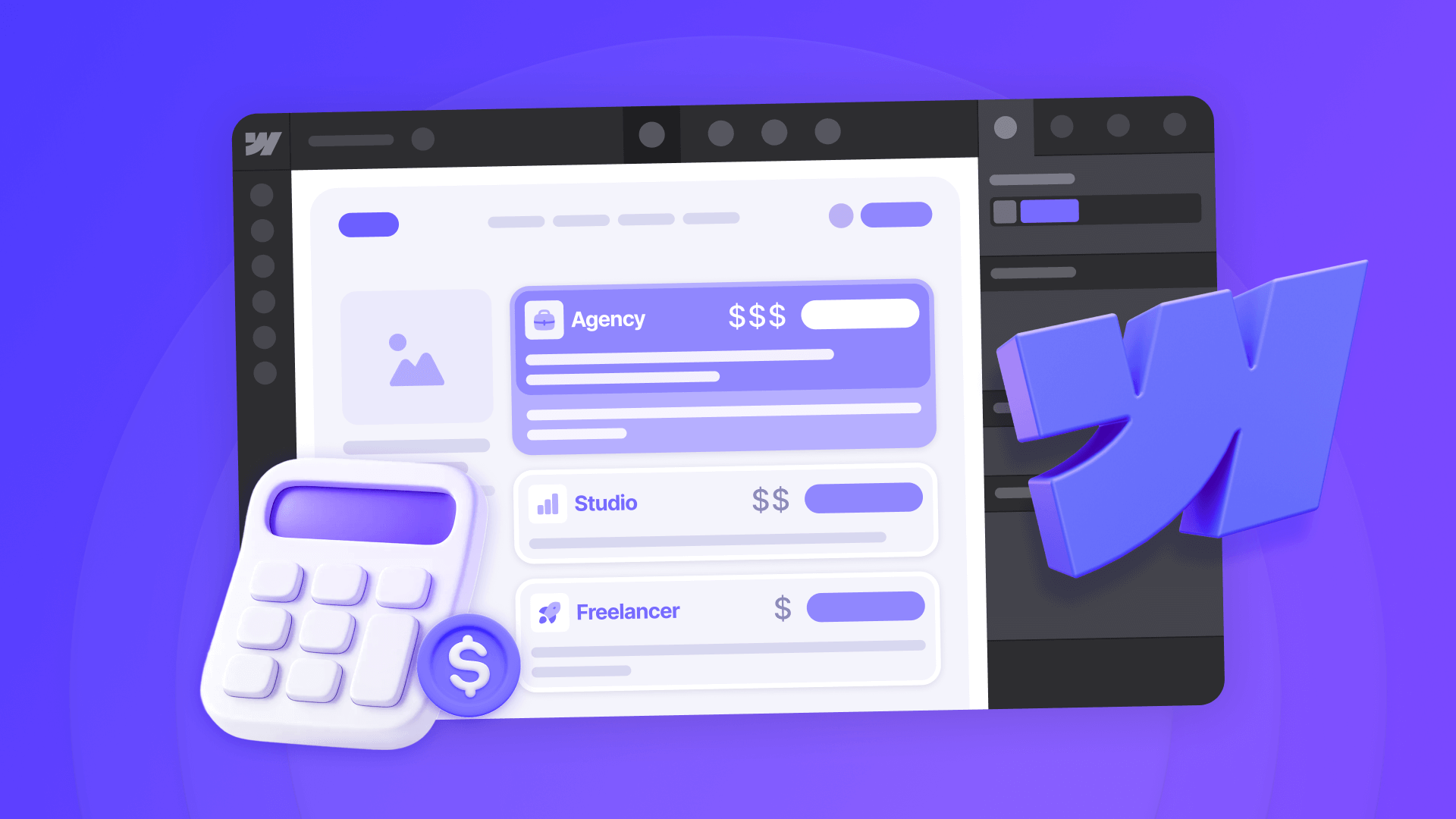
How much does a Webflow website cost in 2025?
Webflow website costs explained: pricing factors, quality tiers, cost calculator, and how to choose between freelancers or agencies.
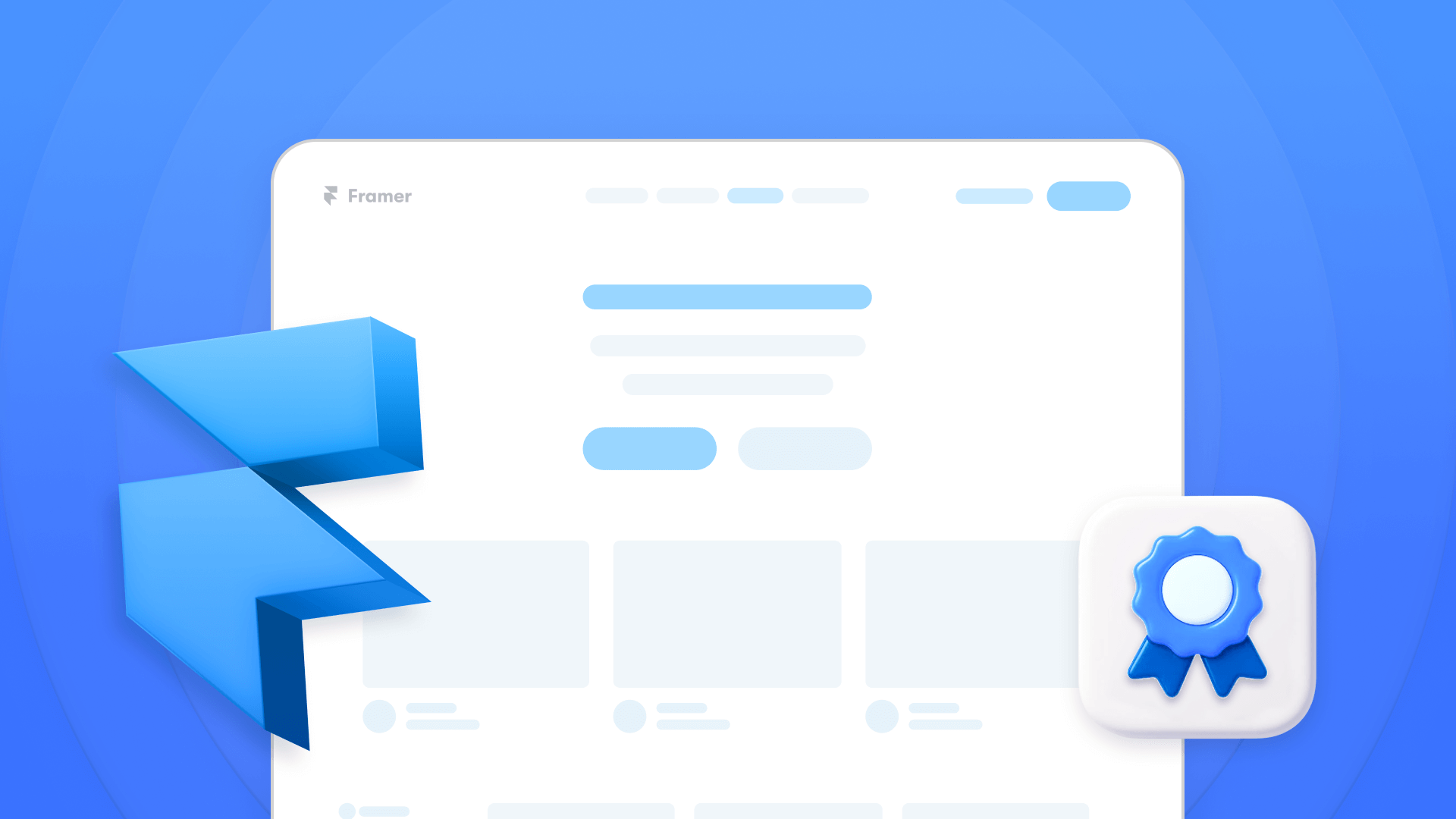
The best Framer agencies of 2025
Discover the top Framer agencies of 2025 with proven expertise in Framer design, development, and digital experience.

How to find the best Framer agencies for your project
Find vetted Framer agencies via expert directories, reviews, and showcases to compare platforms and make smart hiring decisions.












